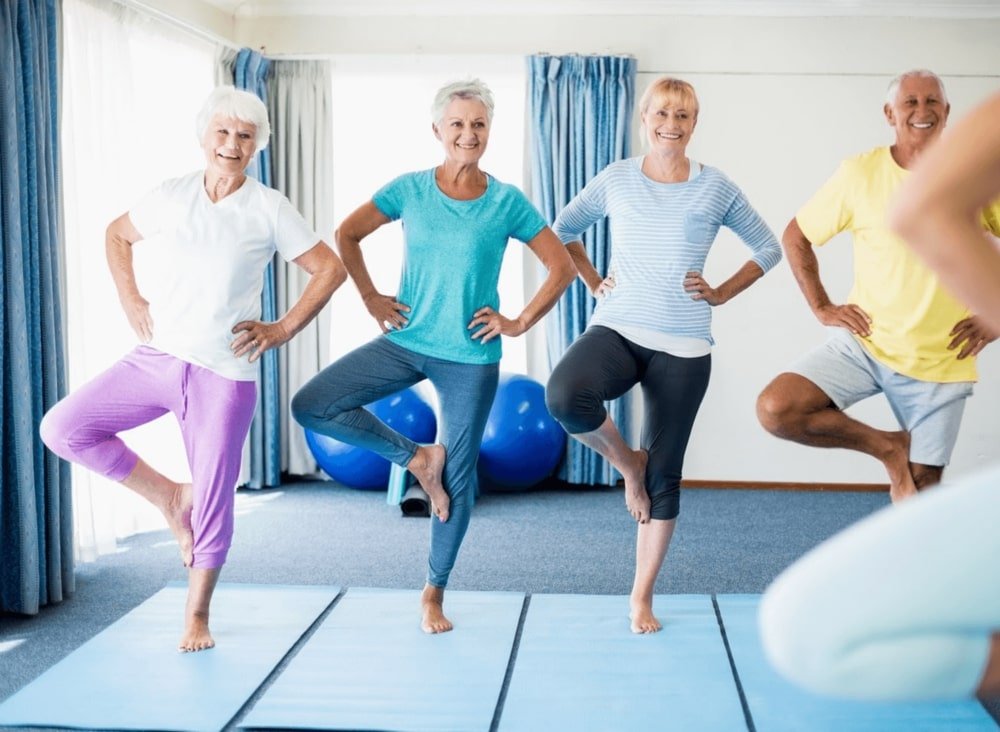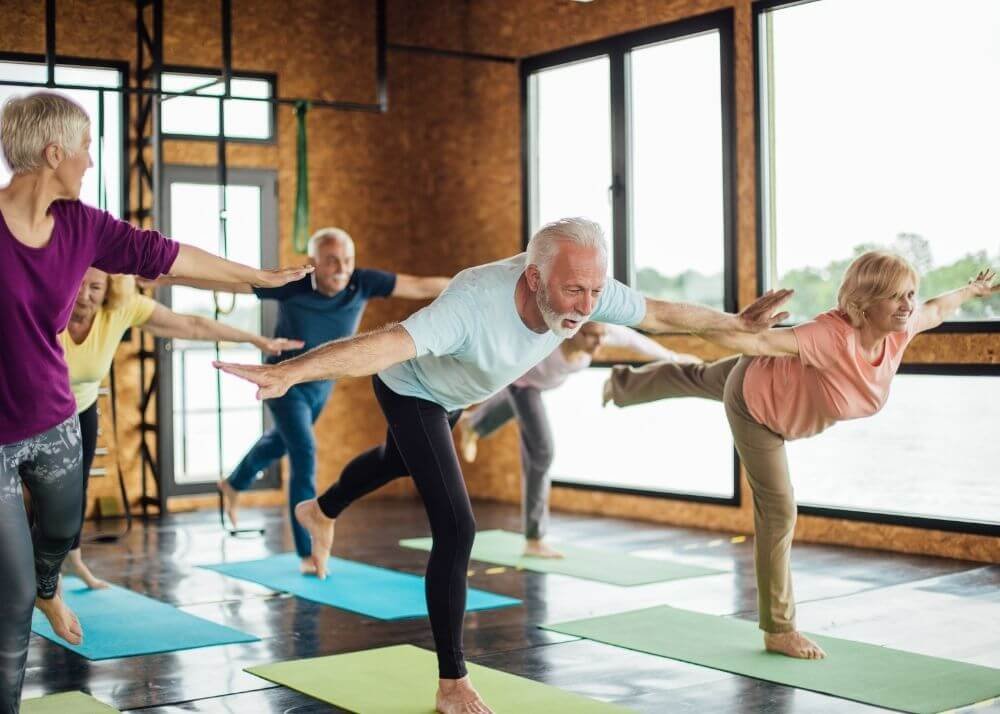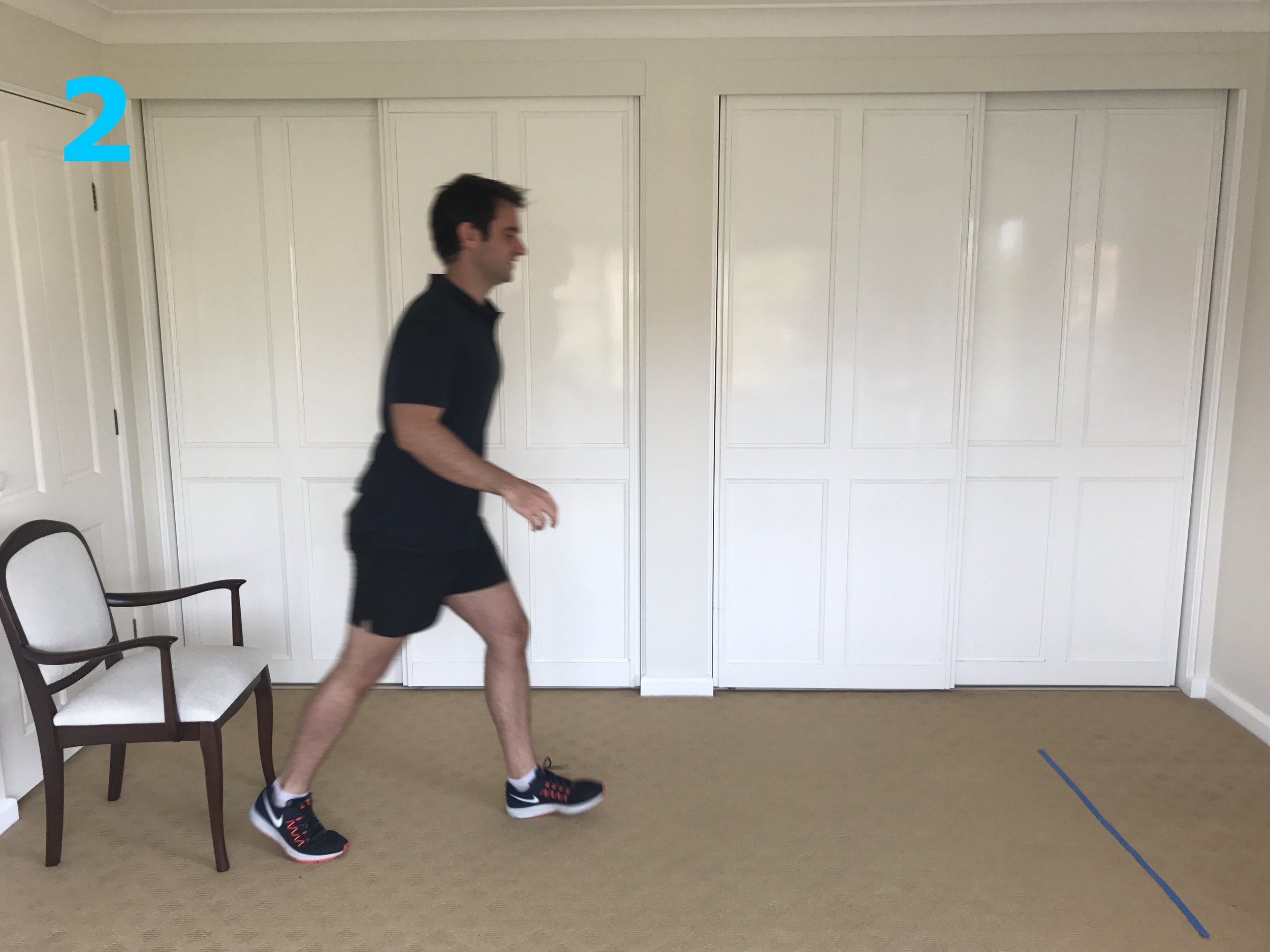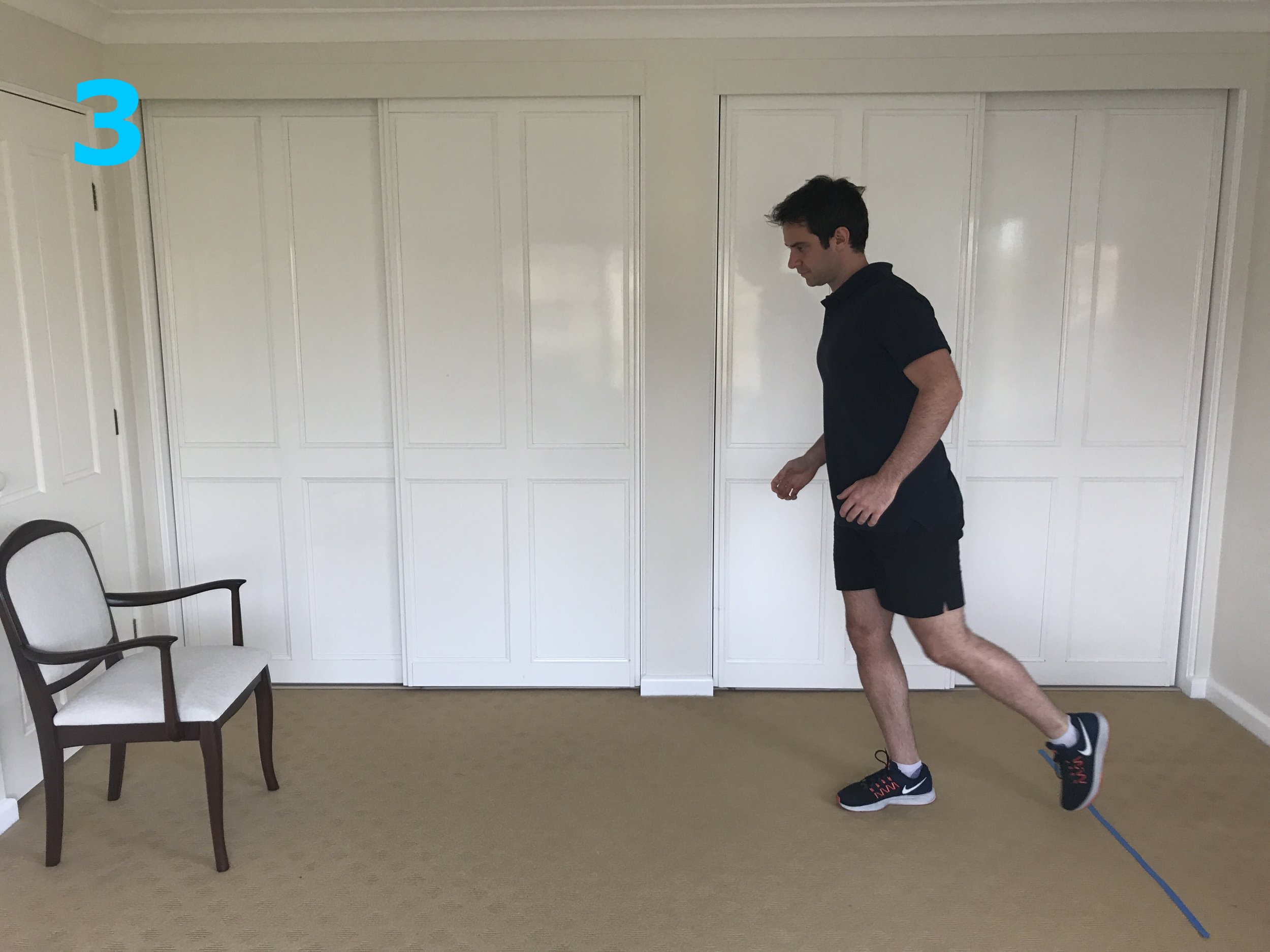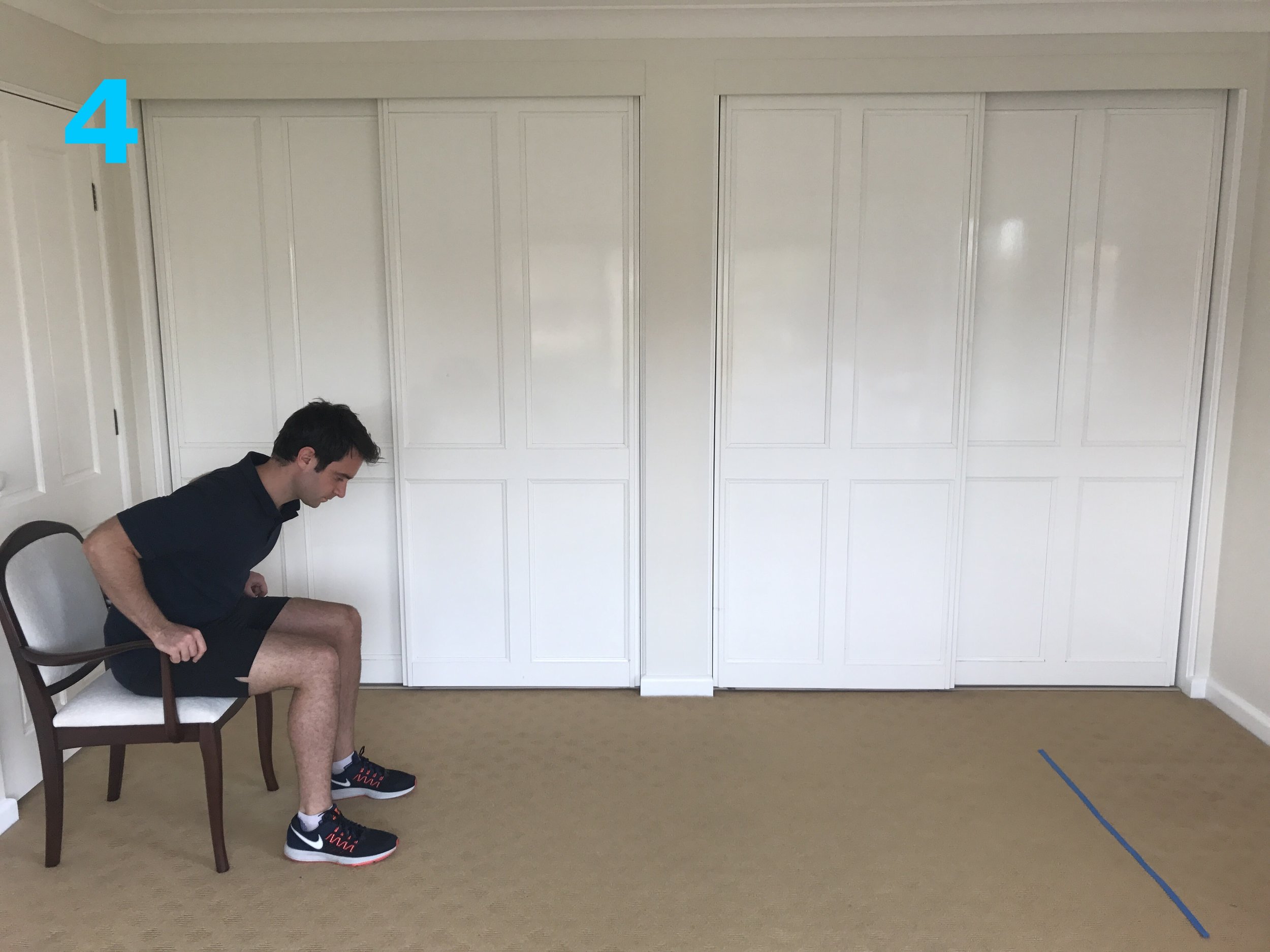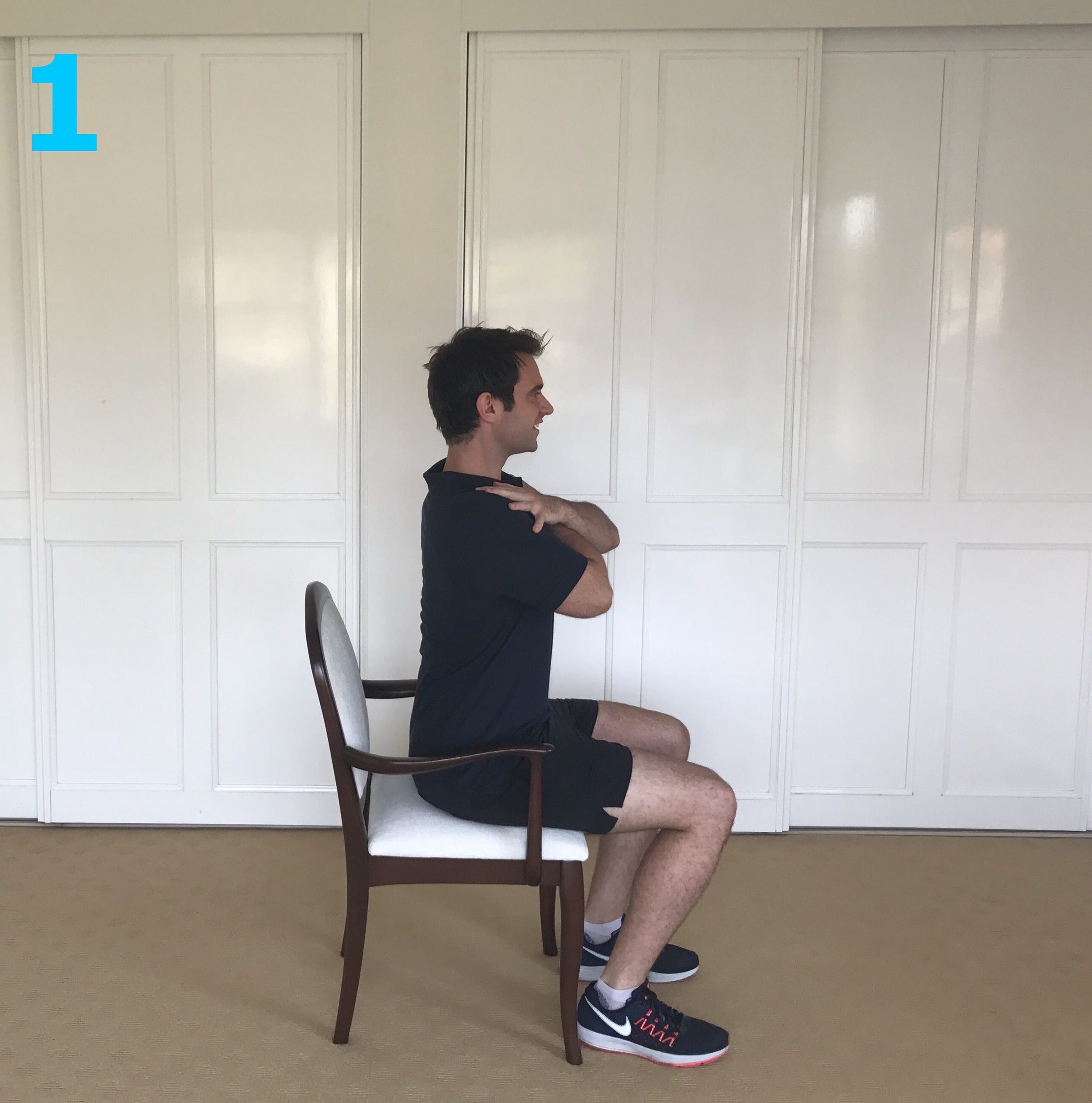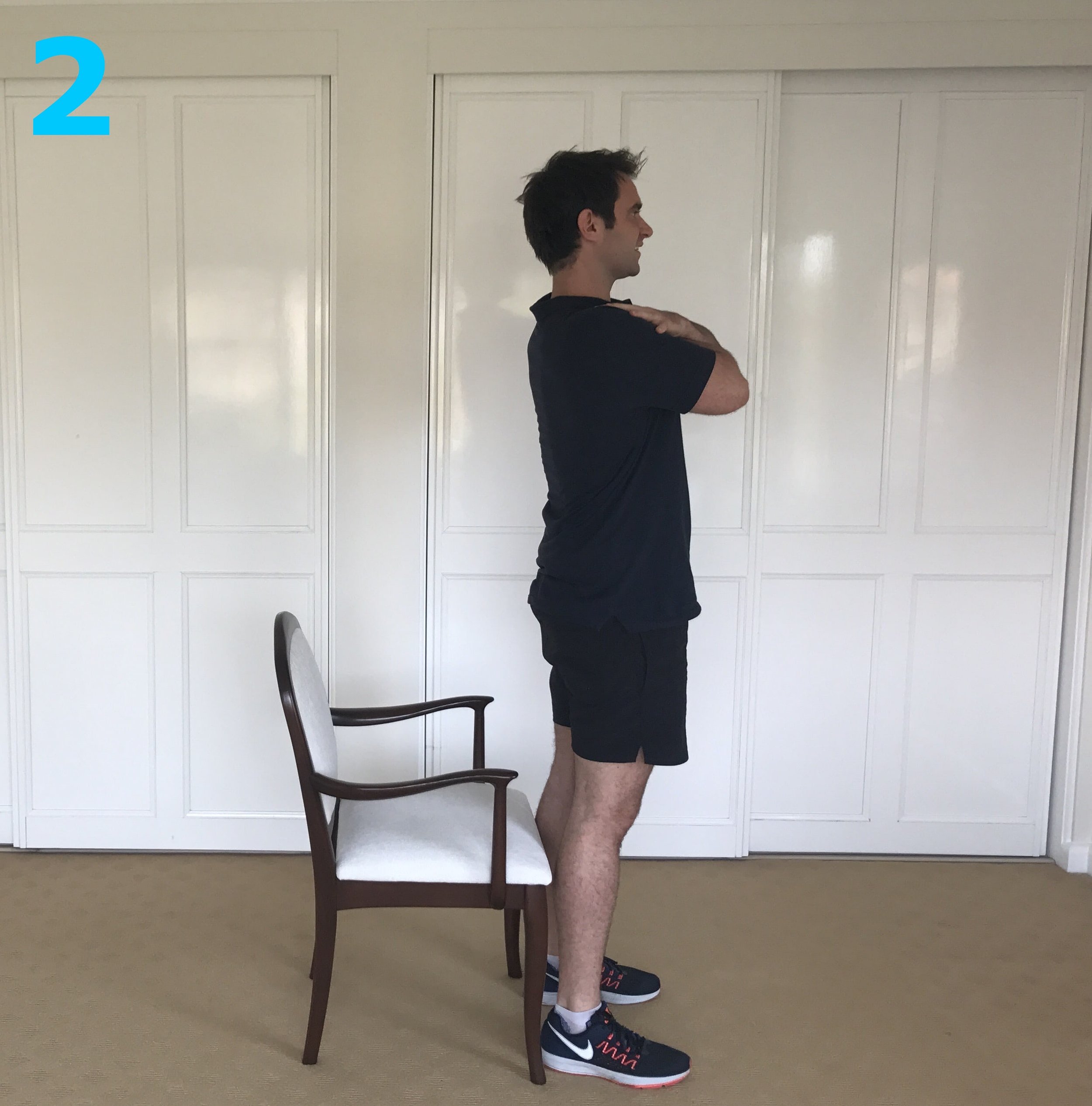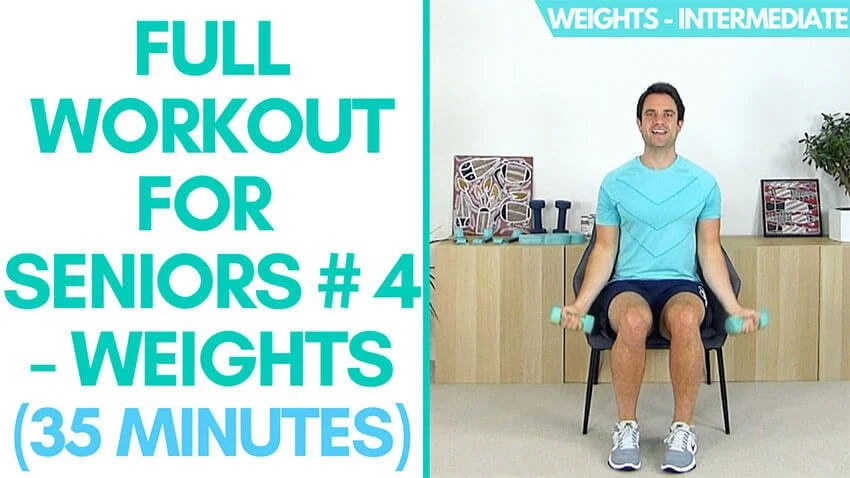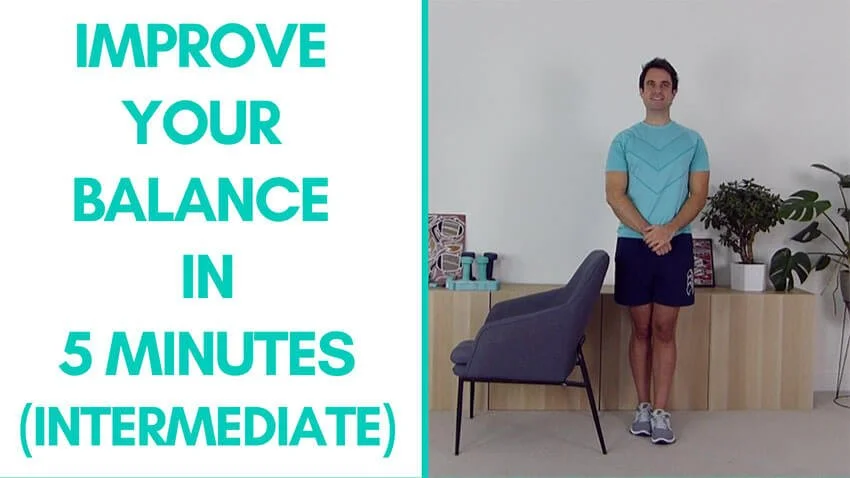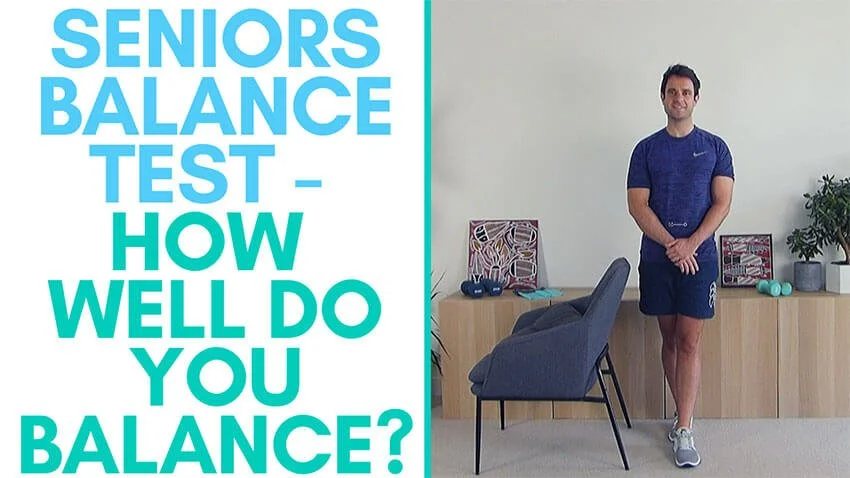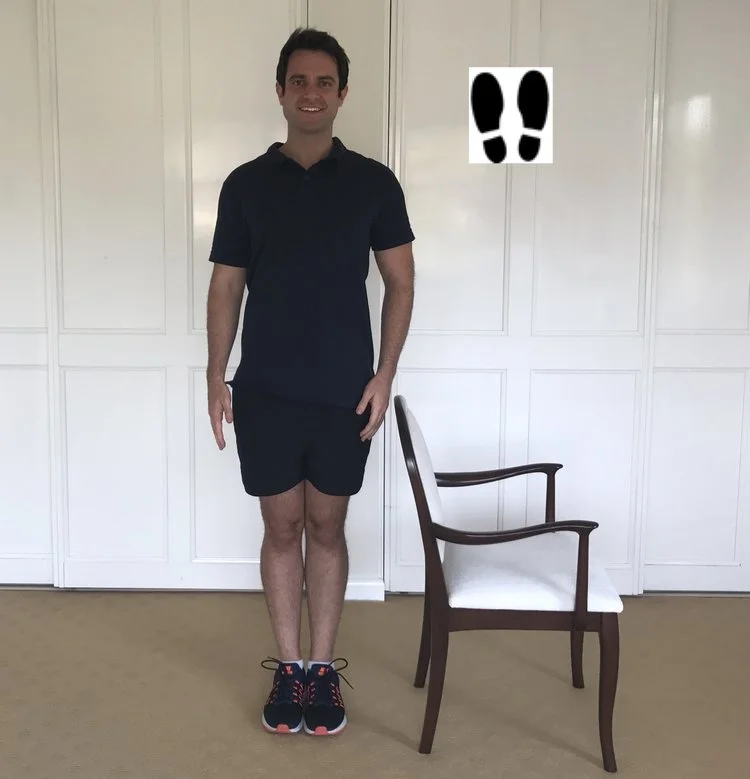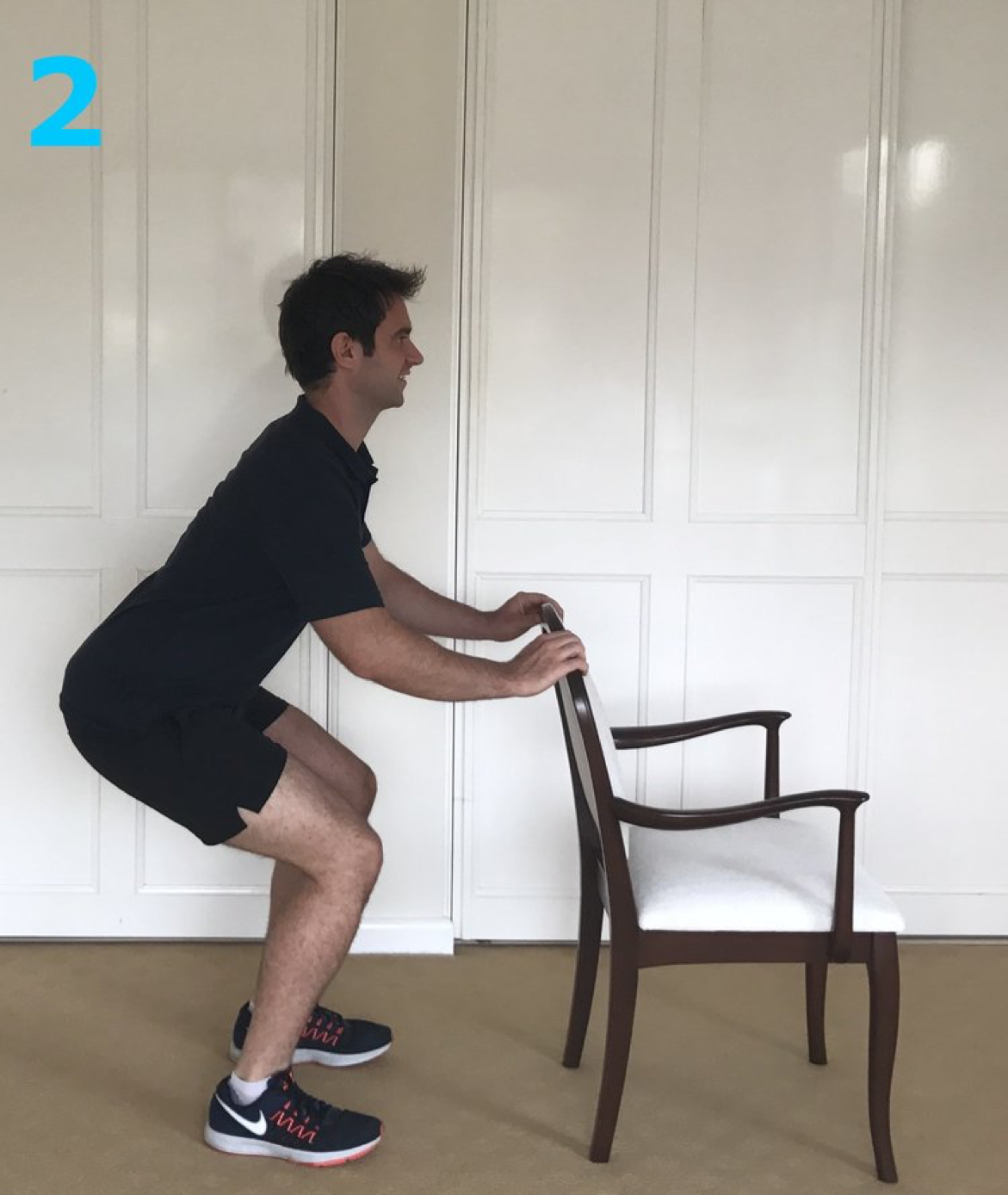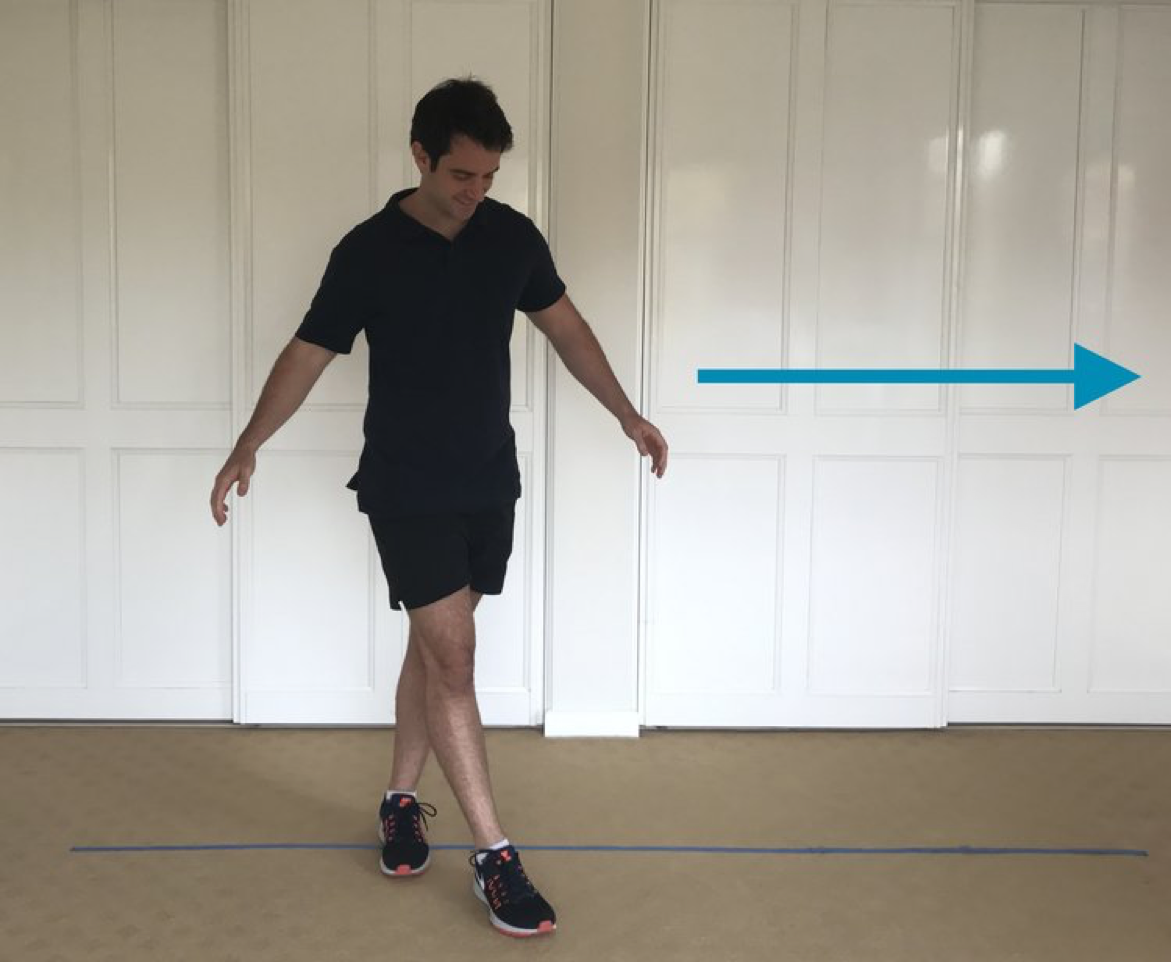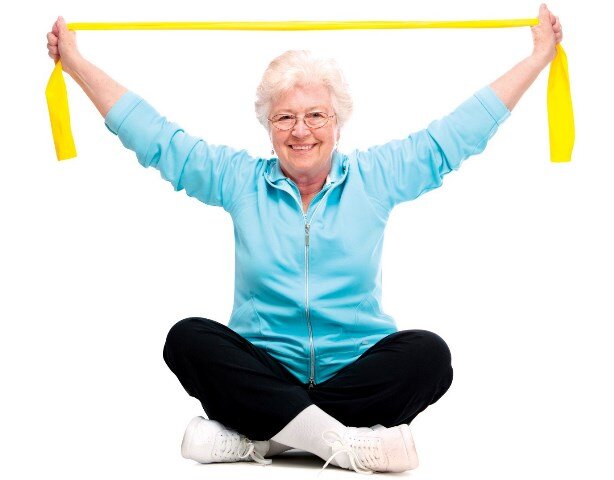
More Life Health blog. Discussing:
Seniors Exercise. Seniors Health. Seniors Fitness. Fall prevention for Seniors and more!
8 Minute Morning Balance Routine for Seniors
In this video, we go through balance exercises to do each morning to improve your balance and decrease falls.
DAILY BALANCE Routine For Better Stability
Follow along with me (Mike - Physiotherapist) in Australia for these Balance exercises and relaxation to do each morning to improve your balance and decrease falls.
This balance routine helps improve stability, you can do it each morning. I’ve also incorporate some breathing to relax your body and start your day off right.
Remember, balance is a skill... and it's a crucial skill to practice as we age. And… you CAN improve your balance, no matter where you're starting from.
It is another video I have recorded outdoors in nature from Fleurieu Peninsula, South Australia
To view this video, click the video below (or HERE).
For more about balance, you can read my article HERE.
Stay active, stay happy! and I’ll see you soon!
- Mike
THE STEADY SENIOR: The Complete Guide To Great Balance Over 60
Training balance is a great way to achieve your health and fitness goals, to prevent falls and keep you getting the most out of life. In this article you'll LEARN what is necessary to improve your balance (PART 1), How to test your balance in your own home (PART 2) and everything you need to improve your balance (PART 3) all in the comfort of your home.
FIRST PUBLISHED: 22/5/2017. LAST UPDATED: 10/2/2024
Good balance is essential to keep you steady on your feet, prevent falls and ensure you get the most out of life!
With good balance, you can go about your days effortlessly!
As we get older, however, it's common for our balance to worsen, which means life becomes harder (and not to mention more dangerous)!
But, BALANCE IS A SKILL! A SKILL THAT CAN BE RE-TRAINED AT ANY AGE!
And,
YOU CAN IMPROVE YOUR BALANCE, NO MATTER YOUR CURRENT CAPABILITIES!
In this guide, I will teach you all you need to improve your balance, show you how you can test your current balance and give you all that is required to begin balance training and keep you balancing well, for life!
All in the comfort of your own home!
You don't need special equipment, and you don't need to join a gym.
It's easy, and it can be enjoyable.
Oh, and by applying what's in this guide, not only will you build great balance, the same exercises help you get stronger, fitter, look better, feel better and increase your confidence!
We are going to make some real progress!
So let's get balancing well!
WHAT WE WILL COVER IN THIS GUIDE:
PART 1: ALL ABOUT BALANCE FOR SENIORS
1.2 HOW YOUR BODY KEEPS YOU UPRIGHT
1.3 WHY BALANCE WORSENS WITH AGE
PART 2: HOW TO TEST YOUR BALANCE
2.1 EQUIPMENT TO IMPROVE AND TEST YOUR BALANCE
2.3 HOW TO KEEP TRACK OF YOUR BALANCE
PART 3: HOW TO IMPROVE YOUR BALANCE OVER 60
STEP 2: DO SPECIFIC BALANCE EXERCISES
THE BEST BALANCE EXERCISES FOR SENIORS
STEP 3: ALWAYS CHALLENGE YOURSELF
STEP 4: HOW TO BE MORE MINDFUL
Before we get started, remember, this guide will only help you if you apply these strategies. Just reading what's here and trying the exercises maybe once will not help you improve your balance.
If you want to improve your balance, read the article and undertake what's set out in this article.
Pledge to incorporate at least 5-10 minutes of balance work into your life a few times each week. Make it simple. Make it fun!
To make it easy for you; I create workouts for mailing list subscribers. So make sure you join up!
PART 1. ALL ABOUT BALANCE FOR SENIORS
1.1 WHAT IS BALANCE
If you had to guess what balance is, most would probably guess something along the lines of “being able to stand upright, without falling”.
Which is good, and all you need to know! However, a better definition is this:
“BALANCE is the ability to maintain the line of gravity of a body (vertical line from the centre of mass) within the base of support with minimal postural sway” [1].
Let’s break this definition down, so it’s easier to understand.
When you gain a better understanding of balance, you know why we do the exercises to improve balance and why we could, or do, fall.
Diagram 1: To lose balance my sway has to move past my limits of stability.
1) Centre of Mass – The easiest way to think of our centre of mass is the point where our weight is concentrated most (orange circle in diagram 1). The lower our centre of mass, the easier it is to stay balanced.
2) Base of Support (BOS) - The area beneath a person that includes every point of contact that the object or person makes with the supporting surface [2, 3].
In this photo (yellow line), my feet are together- a reduced base of support, which means less stability.
A wider base of support increases our stability.
Standing with our feet apart makes standing a whole lot easier because it increases our stability.
Using a cane or a walker makes us sturdier, why? Because we have increased our base of support by increasing the area within the support surface (that being the floor).
3) Sway - The horizontal movement (red arrows at the top of diagram 1) between each side of the centre of gravity (green line) even when a person is standing still [1].
What happens when we are trying to balance in challenging positions? We sway from side to side.
Here is another picture to help you understand everything a little better:
Diagram 2: By standing on one leg my base of support is decreased. Less sway is required for me to become unstable and lose balance.
By decreasing our base of support, (standing on one leg), we decrease stability. It is much easier to sway outside of the limits of stability (blue lines). It now becomes easier for us to lose balance and fall.
We can also decrease the base of support in exercises, to make them more challenging, which, over time, will help improve balance.
To increase our base of support, we can hold onto the chair in front of us to provide more stability and lessen our chance of falling.
There are two types of balance; static balance and dynamic balance.
1) Static Balance - The ability to balance while at rest, e.g., standing still on the spot. (The diagrams above are examples of static balance.)
2) Dynamic Balance - The ability to balance while moving, e.g., walking or reaching forward.
Both types of balance are equally important and both need to be practised to have great balance.
Your aim should be to become as stable as possible by doing balance exercises consistently, without having to rely on any assistive devices (walker, cane, etc.).
An aim that is entirely possible by putting in the work of doing the correct balance exercises.
[Note: Only stop using an assistive device if it is safe to do so. Always get a professional opinion to decide on this].
1.2. HOW OUR BODY KEEPS US UPRIGHT
So how does our body keep us upright? Notice I didn't say "how do we stay upright?"! That's because balance is usually an automatic process (unless compromised in some way).
For every task we undertake, our body automatically receives information from our senses. This information is from our muscles, joints, ligaments and other sensory receptors such as touch, pressure, temperature and pain.
Sensory information also comes from our visual system (our eyes) and our vestibular system (our ears).
This sensory information is sent to our Central Nervous System (CNS) to be processed.
The CNS then cues our musculoskeletal system (system for our muscles, bones, ligaments, joints) into action to perform the appropriate movement.
When we are walking (or undertaking any other tasks), our central nervous system continually sends signals to our musculoskeletal system.
If we were to come across uneven terrain or obstacles or were to trip, for example, during our walk, our musculoskeletal system will receive the information via our CNS and make the correct postural adjustments to maintain our balance and keep us from falling.
This is an automatic process that all happens very, very fast, but slows as we age!
As this process slows, combined with the loss of other factors, e.g., decreased leg strength or proprioception (perception or awareness of the position and movement of the body), it becomes increasingly difficult to maintain balance.
When you train balance and improve balance, this process becomes more effective, ensuring you stay on your feet.
Decreased eyesight (or closing your eyes) or conditions of the inner ear (vertigo, Meniere's disease, ear infections, or prolonged dizziness), also affect balance.
Additionally, certain medications and hypotension (low blood pressure) - leading to dizziness and lightheadedness - can also affect our balance.
1.3 WHY BALANCE WORSENS WITH AGE
As I mentioned above, the process of maintaining our balance slows or deteriorates as we age.
There are factors out of our control that we must accept.
That is, changes in our body (physiological changes) do happen because of ageing itself. We will never be like our young 20, or 30-year-old selves.
However, the good news is, the primary contributor to these physiological changes is not due to ageing in itself, but because we do less as we age.
As we start reaching adulthood, the pressures of life take hold, and we find ourselves with more obligations.
We also get into some poor habits (e.g., sit more often in lousy postures), and we do less and less activity.
A lot of us put these physical changes we see (such as decreased balance, posture and strength, etc.) down to ourselves getting older.
However, the majority of the time, these changes occur because we do less activity throughout the years.
It’s simply because we sit more and move less, that we see a lot of these changes in our physical condition.
We are creatures of comfort designed to do what is most comfortable and, after time, it becomes increasingly difficult to do more activity.
These physical changes we see from lack of use include:
Generalised weakness throughout the body.
A generalised decrease in fitness (our whole body becoming less fit, leading to faster muscle fatigue and shortness of breath).
Decline in posture, changing our centre of mass.
Decreased reaction time.
Decreased balance.
It’s time to accept that the main reason staying active and upright has become tougher and you are not moving as well as you could be is not because of ageing itself but because we have progressively done less and less activity.
You must get it out of your head that decreased balance and, also falls, are a normal part of ageing. This is a myth.
Your BALANCE CAN BE IMPROVED, and FALLS CAN BE PREVENTED
Now that we know this, we should do everything in our power from now on to improve our balance and keep it that way for the many benefits it will bring us.
PART 2: TESTING YOUR BALANCE
You do not need to go to a Professional (e.g., a Physiotherapist) or join a gym to get your balance tested.
You DO, however, have to be careful and take the correct steps for safety reasons.
And... You can also get a more comprehensive test when getting your balance tested by a professional. It is also a good idea so you can rule out any vestibular or visual issues as the cause of any balance problems.
However, when done safely (with a helper and the correct equipment), testing your balance at home is a great way to take your health into your own hands and start making changes.
I've chosen some simple tests you can do to test your balance, and I'll show you how to do them as safely as possible, in the comfort of your own home.
2.1 HOW TO TEST YOUR BALANCE
There are many tests we can use to measure balance.
The aim of testing your balance is to get a rough guide on how well you can balance, and then use these measures as a guide of progress after doing balance training.
I have chosen four tests to give you a rough guide of your balance.
However, before we get into the tests, there is some basic equipment you will need:
EQUIPMENT YOU WILL NEED:
To test and train your balance sufficiently, I recommend the following:
· A tape measure
· Masking tape - Preferably coloured as it is easier to see.
· Timer - You can use the timer on your mobile phone.
· Chair – Standard chair with arms. Not a couch.
· Sturdy piece of furniture - (e.g., kitchen bench, rail, etc.).
· A Wall.
· A helper – grab a family member, friend, exercise partner, whoever to help take measures.
BALANCE TESTS
Now let's get into the testing.
TEST 1 - FOUR POINT BALANCE TEST
Equipment For Test: You will need a timer and a chair
Details of Test:
This first test is a test of our static balance (balance while stationary). This test will challenge your balance in four increasingly difficult foot positions.
How To Perform The Test (photos below):
1. Standing next to the back of a chair or a rail or sturdy piece of furniture, (e.g., kitchen bench) for safety reasons.
2. Starting by holding onto the chair and taking up the first foot position of the test (see below).
3. When you are ready, take your hands off the chair and start the timer.
Do this test without holding onto the chair.
4. During the test, you can move your arms to retain balance (holding onto the surface if required). Once your feet move out of position, the test is stopped and the time recorded in the chart below.
5. If you can safely manage the position for 30 seconds, you can continue on to the next challenging foot position and continue until the final (4th) foot position.
Alternate feet for the single feet stances.
6. Record your results in the table following this section.
NOTE: If you are unable to manage 30 seconds for this foot position, stop the test and record your time.
If you are unable to maintain 30 seconds for foot positions 1 and 2, keep practising these movements, train these movements each day, until you can safely manage 30 seconds for each before continuing.
If you are not improving, see your doctor or Physiotherapist for a more personalised program.
FOOT POSITION 1) Feet Side by Side:
Feet as close together as possible, side by side.
Chair or rail close by for safety reasons.
Hold for 30 seconds, or as long as possible.
If you can hold for 30 seconds, safely move on to the next position.
FOOT POSITION 2) Semi Tandem Stance:
Standing with the big toe of one foot in the arch of the other.
Toes facing forward.
Chair or rail close by for safety reasons.
Hold for 30 seconds, or as long as possible.
If you can hold for 30 seconds, safely move on to the next position.
Alternate Feet.
FOOT POSITION 3) Tandem Stance
Standing with heel on one foot touching toes on other.
Chair or rail close by for safety reasons
Hold for 30 seconds, or as long as possible.
If you can hold for 30 seconds, safely move on to the next position.
Alternate Feet.
FOOT POSITION 4) Single Leg Stance
Standing on one leg.
Chair or rail close by for safety reasons
Hold for 30 seconds, or as long as possible.
If you can hold for 30 seconds, safely move on to the next position.
Alternate Feet.
Understanding Your Results:
Scoring 30 seconds on each test means your balance is good for this test.
No matter your capabilities, you can always be improving. To do this, you must challenge your balance even further by making the balance training harder (discussed later).
There is always work we can do.
Scoring less than 30 seconds on any of the tests, do not be hard on yourself; it just means you need to be practising your balance more so.
Do not be concerned if you score less on one side compared to the other side (i.e., your left foot vs your right foot); this is common.
If you are over 60 and score less than 10 seconds on the tandem stand, you are at increased risk of falling.
No matter your results, write them down with an aim to improve them after your training period.
TEST 2 - STANDING REACH TEST
Equipment For Test: You will need a chair, a bare wall, a tape measure and a helper for safety reasons.
Note before: You can stick a tape measure on the wall to make this easier for you.
Details of Test:
The standing reach test is used to assess our balance when standing and reaching for objects [4].
How To Perform The Test:
1. Standing perpendicular to a wall, place a piece of tape on the wall at the level of your shoulder. This is to reference your start position.
2. Keep a chair within reach for safety reasons.
3. Now stand perpendicular to the piece of tape and roughly 15 cm from the wall, facing straight ahead and feet hip-width apart.
4. Now with the arm closest to the wall, lift your arm to 90 degrees, parallel to the floor. Keep your hand in a fist and stay relaxed, with your feet or torso not moving out of position.
Mark the position of your knuckle on the wall, with a piece of tape. This is the start position (position A).
5. Now reach out in front of you as far as safely possible, keeping your arm parallel to the floor.
Ensure you remain balanced without your feet coming out of position. This is the final reach position (position B).
6. When you have reached out as far as you can, have the person helping you mark where the knuckle of your fist is with a piece of tape.
Ensure you don't overreach and lose your balance.
A - B = Reach Distance
7. Using the tape measure, measure the distance from the two tape points and record the results in the table following this section.
8. Complete a practice run and then have three attempts of this test.
9. Average the results of the three tests and record your results for later use.
Understanding Your Results:
Scoring less than 18.5 cm indicates you have an increased risk of falling.
No matter your results, write them down with an aim to improve them after your balance training.
TEST 3 - TIMED UP AND GO (TUG TEST)
Equipment For Test: Chair, Tape Measure, Tape, Helper
Details of Test:
The TUG is another test of our balance and our mobility.
In this test, you will stand from a chair, walk 3 metres over a line, turn around, walk back to the chair and sit down.
How To Perform The Test (photos below):
1. Ensure you have a friend or family member with you to help you with this test.
A friend can take a more accurate reading of the time it takes you to do the test and, additionally, if your balance is not so good, it’s good to have them there for safety reasons.
As with all balance tests, ensure they do not assist you with any parts of the test, but it is a good idea to have them standing alongside you.
2. Place your chair in an open area of your house, on flat ground without any obstacles or trip hazards in the way.
3. Using your tape measure, mark 3 metres from the chair and place a piece of tape to mark this spot.
4. Start seated in the chair, with your hands on the armrests and back against the backrest.
5. Your helper will say “GO” and will start the timer. You are to stand from the chair, walk to the line, turn around, walk back to the chair and then sit back down. Walk at your normal pace.
6. Once your buttocks have touched the chair, the test is complete, and your helper will stop the timer.
7. Complete a practice run of the test to get the hang of the test but give adequate rest before the scoring test to ensure you are not tired.
8. Perform this test twice and average your results.
Note: If you usually use a walking aid of some sort (for example walking stick, walker), use this during the test.
Understanding Your Results:
Studies have shown that if your time is over 13.5 seconds, you may be at a greater risk of falling [5].
No matter your results, write them down with an aim to improve them with balance training.
TEST 4 - Sit to Stand For Five Test
Equipment Needed For Test: A Chair, A Timer, A Helper.
Details of Test:
This test is used to test our lower limb strength and power. It is a functional test as sitting and standing from a chair is something we do many times during the day.
This test measures how long it takes you to stand up and sit down five times.
How To Perform Test:
1. Have a helper to time you or hold the timer in your hand.
2. Start seated on the chair.
3. You’re going to time how long it takes you to stand up and sit down [You will start the test (and the timer) as soon as your buttocks leave the chair. And stop the timer (finish the test) when your buttocks are on the chair after the fifth stand].
4. Place your arms across your chest, not holding onto the armrests. Feet hip-width apart.
[If you need to hold onto the armrests, this is fine. However, note it down. You will most probably find after training and improving your balance and strength you will not need to hold on anymore.]
5. When standing up - ensure your knees and hips are straight, and the back of the knees aren’t touching the chair.
6. Ensure when you sit down it is in a controlled manner, not flopping down into the chair.
7. Practice one stand and sit before commencing the five attempts, to get the hang of the test, but do not tire yourself.
7. Perform this test and record all results for later use.
Understanding Your Results:
The normal measures for age ranges are as follows [6]:
60 to 69 years old: 11.4 seconds to complete the test.
70 to 79 years old: 12.6 seconds to complete the test.
80 to 89 years old: 14.8 seconds to complete the test.
No matter your results, even if you can’t perform one sit to stand. Write it down with an aim to improve them after training your balance.
2.3 TRACKING YOUR BALANCE
When you start performing balance exercises consistently, you will begin feeling the differences in many ways.
You'll be more confident going about your day and movement will be effortless.
However, if you are super keen and want to track how much you are improving with your balance, I have created a table to help you track your results. To download this table, click the button under the video below.
After training (next section), you can then retest and compare your results to see how you are progressing.
If you found you had some trouble with these tests, this is fine. These tests are only a guide to check your balance and track your progress.
On the other hand, some of you may find the tests very easy and scored quite well in them.
Great. It means your balance is at a level where you can function well in your day-to-day life. However, this doesn't mean you shouldn't do balance exercises.
No matter what stage you are at with your balance, there are always ways to challenge yourself and be improving. With exercise comes many benefits.
For an easy to follow balance tracking video, watch the video below.
Also, you can track and record your balance by downloading the below.
Now we’ve got an idea of where your balance is at, let’s now start improving your balance!
PART 3: HOW TO IMPROVE YOUR BALANCE FOR SENIORS
STEP 1 - GET MOVING
The first and most important step in improving our balance and our quality of life is to get active. You need to get off the couch and get your body moving.
Movement is health. Movement is medicine.
Being active or exercising doesn't have to be boring or a chore.
Do what you can to make it easy. Do what you can to make it fun. Do whatever it takes to ensure you'll stick to moving more. Consistency is what's most important.
Go for a walk in nature, go for a swim, try a new activity if you can (examples - Tai Chi, lawn bowls, ten pin bowling, aqua aerobics, golf, tennis) the ideas are limitless, just get moving, within your capabilities.
My recommendation is to go walking every day outdoors for at least 10 minutes.
Have fun with it. Mix it up. Go on different walks. Attempt different terrains. Walk up stairs. Down stairs. Walk on grass or in shallows, and sand of your local beach. Go bushwalking. Walk faster. Slower.
Have fun and find the inner child we all have inside of us. Get outdoors and enjoy what mother nature has to offer.
Don't get carried away and do too much too soon, however. Don't try anything out of your capabilities.
If you're walking up many stairs for the first time in a long time, take breaks, use the rail and ask a friend or family member to come along for safety and to have some company. Take your walking aid if you need to.
Hurting yourself or falling would make both of us unhappy.
So make sure you slowly progress your walks, mix it up and continue to challenge yourself each week.
Yes, you're at higher risk of falling by getting off the couch, but done safely and when you enjoy the activity, you stay consistent.
There are many reasons why staying active is essential for better balance and better physical health.
You are training your heart which will make you fitter; you are training all the muscles in your body which will make you stronger (even the little ones that help with balance), you are ensuring your joints don't stiffen up, you are training your body to respond to different terrains. You will be decreasing your falls risk and improving your balance.
START NOW!
Get the all-clear from your doctor and begin with at least 10 minutes a day of some physical activity that you enjoy. Only 10 minutes, you can do it!
Always be thinking of ways you can incorporate more activity, or exercise, into your life.
STEP 2 - DO SPECIFIC BALANCE EXERCISES
Now we are moving more; we are going to incorporate some balance exercises into our life to directly improve our balance.
When performing these exercises, ensure you focus on proper technique; this is the golden rule for any exercise.
Quality is more important than how many of the exercises you can do, how fast you do them or how much weight you lift (if doing some resistance training).
With that in mind, if you feel the exercises do not feel right, causing pain or at first sign of fatigue, stop them.
You want to ensure you are performing the exercises correctly, working within your capabilities and, at the same time, challenging yourself, so you are getting the most out of the exercises and hence, improving your abilities.
THE BEST BALANCE EXERCISES FOR SENIORS
Specific balance exercises are essential to improve your balance and you want to be performing the best exercises to make greater improvements in a shorter time.
CLICK HERE FOR THE BEST BALANCE EXERCISES FOR SENIORS
Make sure you have read this entire article, from the beginning, before progressing to these next steps.
Additionally, for videos you can follow along with to improve your balance, head to the balance section of this website (click here) and follow along with the balance videos.
STEP 3 - ALWAYS CHALLENGE YOURSELF
For some of you, performing these balance exercises may be too difficult. For others, they could be too easy.
A one size fits all program is not possible. We are all unique people with different capabilities.
The good news is, by understanding more about your balance and your base of support, you can modify the exercises to make them easier or more challenging depending on your capabilities.
Remember that if we increase our base of support, we are more stable. When we decrease our base of support, we are less stable.
If any of the exercises are too hard and you find yourself swaying too much, we can take it back a little and make it easier by increasing our base of support.
If you find the exercises are too easy, it’s time to make them harder, to challenge yourself.
Always take note of your support base for each exercise as it’s a good way to see how much we can progress and improve each week.
Here are some ways to vary our base of support to make it easier and harder.
Each variation starts at less challenging to more challenging:
Using Walking Aid: e.g. - Walker, Four Point Cane, Single Point Cane
Change Upper Body Supports: e.g. - Two Hands, One Hand, One Finger, No Hands
Change Feet Position: e.g. - Legs Wider Apart, Legs Closer Together, Semi Tandem, Tandem, Single Leg Stance
Change Surface: e.g. - Stable Ground, Foam Pad, Pillow, Cobble Surface, Wobble Board
Other ways we can challenge our exercises are by:
Challenging our hearing systems (vestibular) and visual systems.
Challenging Hearing System – Turn Head from side to side.
Challenging the Visual System – Close Eyes.
Add challenges/tasks: e.g., catching a ball, solving problems, holding a glass of water, turning your head, adding resistance bands or dumbbell, adding a foam board.
Examples:
If you find the single-leg stance too easy, you can close your eyes or turn your head to each side during the exercise. This will make it more challenging.
You can also add in a pillow or a foam board.
If you are finding the single-leg stance too hard, you can make the exercise easier by holding on with one hand and working up to the time required.
STEP 4 - HOW TO BE MORE MINDFUL
I want you to think for a second and tell me, are you one to lose things?
Are you easily forgetful? Have you been known to be clumsy? Bump into things?
If so, I hate to break it to you, but you have a busy mind.
When our minds are busy, we are less present, and we tend to do careless things.
We've always got bruises because we bump into things. We can never find our wallet or keys. We trip because we didn't see that garden hose in front of us.
We are away with the fairies and mindfulness is our tool to bring us back.
Mindfulness is not usually something thought of when trying to improve our balance.
However, it is something I want you to really think about and take seriously.
Mindfulness techniques are growing in popularity, and it's not just a modern trend. There is increasing evidence of the benefits of mindfulness to wellness and other areas of life. In short, it works.
As with everything else I've mentioned on your journey to good balance, you must ensure you are doing what you can to decrease stress and have a clear head/calm mind, every day.
Stress directly affects our balance.
Higher stress levels can cause a decrease in balance performance. Additionally, many patients report an increase in dizzy symptoms during periods of stress.
In a calmer mind, there is less resistance; we are stronger, everything feels easier. When we have a busy mind, everything is harder.
Calm the mind, and we become more aware of our body and our environment around us. Our balance improves and our chances of falling will decrease.
It took me a long time to get into meditation myself to decrease stress. Once I began, stayed consistent and noticed results, I got hooked.
Consistency is the key to any mindfulness practice and 10 minutes is the perfect place to start.
I recommend 10 minutes of meditation each day from now on. You will still get improvements in balance without the meditation and by just doing the exercises; but if you want to make improvements in all areas of your life, this is a great tool to improve your health.
MINDFULNESS TECHNIQUES:
There are plenty of apps and guided meditations online.
Alternatively, here is a mindfulness technique you can use:
When alert, not sleepy, sit in a comfortable chair with your feet flat on the floor. Get comfortable but do not lay down. You don't want to fall asleep.
Set a timer for 5-10 minutes of undistracted time. No distractions, whatsoever. Complete focus. I meditate for 20-minute sessions, but when I first started, I did 10 minutes for quite some time. When you start seeing the benefits and enjoying meditation, you will want to increase the time you sit down.
Play soothing music or sit in silence during your session. A simple YouTube search can help with this.
Ok, now you're ready to go. Start by taking a deep breath all the way in through the nose, and all the way out through the mouth. Repeat this five times with your eyes open
It's now time to close your eyes.
Now take slow controlled breaths in through the nose and out through the mouth. Nice and slow. Continue these slow, controlled breaths.
Continue to focus on the breath. Your mind will wander, this is ok. Do your best to bring your attention back to the body, focusing on relaxing all areas of your body and letting go of any tension or resistance.
Once you start to feel yourself relaxing, shift your focus to the top of the head and slowly move your attention all the way throughout the body, to your feet and back. Focus on relaxing each and every part of your body.
Repeat with the focus on your breath and relaxing all areas of your body for the time set.
Note: It does not need to be perfect. Don't worry if you are struggling. Sit in silence, relax and just enjoy the quiet time. Over time, you will get better.
If you are having a difficult time concentrating, spend the first couple of sessions (maybe a week) just sitting down in silence and processing your thoughts. Listen to them; let them go.
This whole process will get easier with consistency, so vow to make it a daily habit, and you WILL see the results.
ENDING NOTE
There we have it, the guide to improving your balance.
By incorporating all these strategies into your life, you'll begin seeing significant changes in your balance. Stay consistent with the exercises, and it won't be long before you have great balance and are doing more each day, getting more out of life and also decreasing your falls risk.
Good luck on your journey to better balance!
- Mike
SUMMARY TO IMPROVE YOUR BALANCE
To ensure you are on your way to great balance and to make sure you have covered everything, tick the boxes below when done.
🔲 Learn what's necessary to improve your balance.
🔲 Test your balance.
🔲 Include more physical activity in your daily life.
🔲 Perform balance exercises weekly (preferably daily) and make sure you follow along with my exercise videos.
🔲 Become more mindful daily.
🔲 Ensure you are eating and sleeping well.
🔲 Challenge yourself with your balance as you make progress, be patient and stay consistent.
Do you need to improve your balance?
Have you improved your balance by performing these exercises?
I’d love to hear from you.
Leave a comment below, or join the More Life Health Facebook Support Group.
SOURCES
TO VIEW ALL SOURCES USED IN THIS ARTICLE AND FOR ADDITIONAL RESOURCES, CLICK HERE.
Intermediate Balance Exercises For Over 60s | Static & Dynamic Balance Exercises
In this video, we go through intermediate level balance exercises (both static and dynamic exercises) to help you improve your balance and strengthen your lower legs.
Balance Exercises For Seniors
Join me (Mike - Physiotherapist) for these intermediate balance exercises (both static and dynamic exercises).
You can go through this routine two or three times for an even better workout. Make sure you do it at least 3 times a week to start seeing improvements.
Remember to warm-up prior to doing this exercise:
Do your best and any questions ask below!
- Mike
Full Body Workout For Seniors - 60 Minutes (Seated & Standing)
Get stronger, fitter, improve your balance, flexibility and more with this 60-minute, full seated and standing workout for seniors, working every area of the body.
FULL BODY WORKOUT FOR SENIORS (SEATED & STANDING)
Join me (Mike - Physiotherapist) for this 60 minute - seated and standing workout for seniors covering everything you need to get stronger, fitter, improve your balance, flexibility and more!
We get straight into it again today and cover the following:
Do your best and any questions ask below!
- Mike
Full Standing Workout For Seniors - 60 Minutes, Intermediate
Get stronger, fitter, improve your balance, flexibility and more with this 60-minute, intermediate, full standing workout for seniors, working every area of the body.
SENIORS’ FULL STANDING WORKOUT - GET STRONGER OVER 60
Join me (Mike - Physiotherapist) for this 60 minute - intermediate, standing workout for seniors covering everything you need to get stronger, fitter, improve your balance, flexibility and more!
In this Workout we cover:
You can use light hand weights or ankle weights with these exercises.
Do your best and any questions ask below!
- Mike
Whole Body Seated Exercises For Seniors - 55 Minutes, Beginner - Exercise Every Area Your Body
Get stronger, improve your flexibility and fitness, move better and feel better with this 55-minute, seated, full chair workout for seniors, working every area of the body.
SENIORS’ 55-MINUTE CHAIR WORKOUT - GET STRONGER OVER 60
Today’s workout is one that I feel is the best completely seated exercise video I have put together to date (without equipment).
Why do I think this? Because it is the most comprehensive, covering almost every exercise one can do whilst seated in a chair.
We cover the following:
Warm Up
Neck Exercises
Shoulder Exercises
Upper Back Exercises
Arm Exercises
Core Exercises
Hip Exercises
Knee Exercises
Stretches for the Whole Body
Relaxation
As you can see, ALL areas of the body are targeted. It is also the longest we have done to date, going for just under 1 hour.
If you are new to exercise this is the video to start at.
If you can only only do exercise whilst seated, this is the one to start at.
If you’re in charge of a class where everyone has different capabilities, this is the video to put on.
If someone you know is losing strength and mobility, this is the one for them to start at. (Make sure to share it with them).
It’s the ultimate seated workout.
And… If you have been exercising for some time, you can do the exercises standing and/or add in hand weights or ankle weights to make it more challenging.
To get moving with me click the video below.
If 55-minutes is too long for you, I have also uploaded a 35-minute version which covers the main exercises. You can find this here.
I hope you enjoy today’s workout!
Full Workout With Stretch Band For Seniors | 40 Minutes | Intermediate
Get stronger, improve your flexibility and fitness, move better and feel better with this intermediate level, full workout for seniors using resistance bands!
Seniors’ Resistance Band Workout - Get Stronger Over 60
Join me (Mike - Physiotherapist) for this full workout using a resistance stretch band. Again we get straight into it today!
To order the resistance band used in this video, click here.
Get stronger, improve your flexibility and fitness. Move better, feel better. This session goes for 35 minutes.
In this Workout we cover:
Do your best and any questions ask below!
- Mike
FULL WORKOUT WITH WEIGHTS FOR SENIORS | 35 MINUTES | INTERMEDIATE
Get stronger, improve your flexibility and fitness, move better and feel better with this intermediate level, full workout for seniors using weights!
Join me (Mike - Physiotherapist) for this full workout using weights. Again we get straight into it today!
This workout is for those who have been requesting a longer exercise video with weights and a little more intensity. Make sure to start with lighter weights for this video. If new to weights, I would not recommend starting here, start at my introduction to weights exercise video.
Why Dumbbell Exercises?
Let's take a look at why dumbbell exercises are great, especially for older adults.
First off, dumbbells are like the Swiss Army knife of the workout world – versatile, adaptable, and perfect for a range of exercises. Whether you're looking to strengthen your arms, improve your balance, or even enhance your overall stamina, dumbbells have got your back (and arms, and legs!).
One of the coolest things about dumbbell exercises? They focus on 'functional fitness'. That's a fancy way of saying these exercises help you with everyday activities. Think about lifting groceries, playing with your grandkids, or even gardening. Dumbbell exercises strengthen those muscles you use daily.
And hey, let's not forget about the balance benefits. We're not just talking about standing on one foot kind of balance (though that's great too!). Dumbbell exercises help improve your body's stability and coordination, reducing the risk of falls and injuries – a super important aspect for us as we age.
So, to sum it up, if you're looking for a workout buddy that's flexible, effective, and keeps you safe and strong for your daily hustle, dumbbells are your go-to!
Preparing for Dumbbell Exercises
Alright, let's gear up for some dumbbell action! Before we dive in, let's chat about how to prep for these exercises. Safety first, my friends!
Choose Your Tools Wisely: Not all dumbbells are created equal. Start with a weight that feels comfortable – not too light, but definitely not too heavy. Remember, it's like choosing a dance partner; you want a dumbbell that complements your strength.
Set the Stage: Find a nice, open space free of clutter. No one wants to trip over a rogue cat toy while working out!
Dress for Success: Comfortable clothes and sturdy shoes are key. You don't need fancy gym gear; just wear something that lets you move freely.
Warm-Up Time: Get those muscles ready! A little bit of stretching or a brisk walk can do wonders. Think of it as a 'hello' to your body before you start the workout.
Form is King: Before you start swinging those dumbbells, make sure your form is spot on. This isn't just about looking good; proper form prevents injuries and ensures you get the most out of your exercises.
Hydrate, Hydrate, Hydrate: Keep water handy. Sipping water before, during, and after your workout is like giving your body a high-five for the good work.
Get stronger, improve your flexibility and fitness. Move better, feel better. This session goes for 35 minutes.
In this Workout we cover:
Building a Routine
Now, let's build a routine that feels less like a chore and more like a fun part of your day. Remember, consistency is key, but so is listening to your body. Let's find that sweet spot!
Start Slow: Rome wasn't built in a day, and your workout routine shouldn't be either. Begin with simple exercises, and gradually increase the intensity and duration as you feel more comfortable.
Mix It Up: Variety is the spice of life, and it's true for your workouts too. Try different exercises to work various muscle groups. It keeps things interesting and challenges your body in new ways.
Consistency Counts: Aim to incorporate dumbbell exercises into your routine about 2-3 times a week. It's about making a habit that sticks, so find a time that works best for you and stick with it.
Track Your Triumphs: Keep a workout journal or use an app to track your progress. It's incredibly motivating to see how far you've come.
Listen to Your Body: Some days you'll feel like a superhero, and some days not so much. And that's okay! If your body says 'rest', then rest. It's all about finding a balance.
Enjoy the Journey: Remember, this is your time. Enjoy the process, celebrate your progress, and have fun with it. After all, it's not just about getting fit; it's about enjoying a healthier, more vibrant life!
So there you have it – a guide to get you started with dumbbell exercises. Grab those weights and let's make fitness a joy, not a chore.
Here's to feeling strong, balanced, and fabulous at any age!
Do your best and any questions ask below!
- Mike
Full Chair Workout - Standing, No Equipment! | More Life Health
Get stronger, improve your flexibility and fitness, move better and feel better with this standing, full chair workout for seniors.. No equipment required!
Full Standing Workout For Seniors
Join me (Mike - Physiotherapist) for this full standing workout for seniors.
Get stronger, improve your flexibility and fitness, move better and feel better. This session goes for 40 minutes.
In this Workout we cover:
Do your best and any questions ask below!
- Mike
Full Chair Workout - Seated & Standing - No Equipment | More Life Health
Get stronger, improve your flexibility and fitness, move better and feel better with this seated & standing, full chair workout for seniors.
Effective Seated & Standing Exercises For Seniors
Join me (Mike - Physiotherapist) for this full chair workout for seniors (seated and standing exercises).
Get stronger, improve your flexibility and fitness, move better and feel better. This session goes for 35 minutes.
In this Workout we cover:
Do your best and any questions ask below!
- Mike
Fitter in 5 - Advanced Balance Exercises For Seniors (5-Minutes)
In this video, we go through an advanced balance routine. These exercises are a progression from the previous beginner balance exercises and the intermediate balance exercises.
BETTER BALANCE - 5 MINUTES BALANCE EXERCISES (ADVANCED)
In this video, we go through an advanced balance routine. These exercises are a progression from the previous balance exercises:
Beginner balance exercises: https://youtu.be/7j8hDHlaLw4
Intermediate balance exercises: https://youtu.be/E1nrbYspnHY
You can go through this routine two or three times for an even better workout and make sure you do it at least 3 times a week to start seeing improvements.
This video goes for only 5-minutes and it's great for those times you're having trouble with motivation, or you're short of time.
Remember to warm-up prior to doing exercise:
For the Warm-Up Video:
Standing Warm-Up: https://youtu.be/b2DYU7ZQgN0
Do your best and let me know how you went below!
- Mike
Fitter in 5 - Intermediate Balance Exercises For Over 60 (5-Minutes)
In this video, we go through an intermediate balance routine. These exercises are a progression from the previous beginner balance exercises.
BETTER BALANCE - 5 MINUTES BALANCE EXERCISES (INTERMEDIATE)
In this video, we go through an intermediate balance routine. These exercises are a progression from the previous beginner balance exercises: https://youtu.be/7j8hDHlaLw4
You can go through this routine two or three times for an even better workout and make sure you do it at least 3 times a week to start seeing improvements.
This video goes for only 5-minutes and it's great for those times you're having trouble with motivation, or you're short of time.
Remember to warm-up prior to doing exercise:
For the Warm-Up Video:
Standing Warm-Up: https://youtu.be/b2DYU7ZQgN0
Do your best and let me know how you went below!
- Mike
Fitter in 5 - Beginner Balance Exercises For Seniors (5-Minutes)
In this video, we do a beginner balance routine. This video is best for those who are getting started improving their balance and who have some difficulties with other balance exercises.
BETTER BALANCE - 5 MINUTES BALANCE EXERCISES (BEGINNER)
Have you ever felt disheartened when you've tried to do something and couldn't?
This is something I see frequently when it comes to exercise.
It's not uncommon for people to just give up when attempting exercises and find them too difficult. They resort to the fact they're not good enough (which isn't true) and then not continue. Especially when they are new to exercise.
But........ YOU ARE CAPABLE OF DOING WHATEVER IT IS! You just may not be there yet!
And that's ok!
What it takes is consistency and to keep moving forward. Don't give up!
Or.... you may need to take a few steps back by doing a less difficult variation of the exercise and then work your way through more challenging exercises until you can do it.
Which is what we do in today's exercise video. We're going to do some beginner balance exercises.
Click on the video below, to get moving with me!
If you're someone that has trouble with other balance exercises, you can start here and work your way through to more difficult exercises over time. Or, if you want something to get you exercising today, why not do this also!
Tomorrow we'll do intermediate balance exercises and the following day, advanced balance exercises.
Do your best and let me know how you went below!
- Mike
Do This 1 Exercise Daily For Better Balance | Seniors Exercises
Today we do 3-minutes of very quick and simple balance practice - the single-leg stance that when done daily WILL improve your balance.
Daily balance exercise for seniors - get better balance
I'm sure you know that consistency is the key to get the benefits from exercise.
I know it can be difficult at times to stay consistent, however.
Sometimes you feel good, other times not so good and everything but the exercise gets done.
But that's ok! This happens to everyone.
We just need to find a way to make it easier, and when it's easier, it's more likely to be done more often.
This means great results!
So what's a way to make it easier?.........
Do less!
Doing small amounts of exercise consistently is going to get you greater results than more exercise only done every now and then.
Today we are going to apply this "do less" rule with an exercise video that makes it much easier to stay consistent with, to get rock steady balance.
5 minutes of 1 exercise (which I know you've attempted before) daily, is all it takes..
Now let's do it!
Click the video below (or here) to get moving with me.
Another way to stay consistent is to practice this single-leg balance exercise when doing another task - for example when watching TV or brushing your teeth. Just make sure you always do it safely.
Try it for two weeks and watch your balance improve!
You can do it!
That's it from me!
I'll see you for more exercise videos this week (most probably another two) - so stay tuned!
Have Fun, Keep Moving!
- Mike
xo
Test Your Own Balance: The First Step To Improving Your Balance
How well do you balance?
In this video, we go through balance exercises to help you test your own balance.
HOW TO TEST YOUR BALANCE
I'm sure you know that as we get older, our balance can decrease, and you may find yourself becoming more unsteady on your feet.
The good news is balance is a skill that can be re-trained at any age.
The first step to improving your balance is knowing where you are at with it.
Once you know just how good (or not so good) your balance is, you can go about improving it.
Now let’s test your balance!
To test your balance click the video below, or here.
If you want to track your progress, click below for a form that you can print off and record your results on.
If you do find you need to work on your balance, keep the record of your results, get practising with the balance videos, stay consistent and check back into this video in a month..... And enjoy having improved balance.
If you find you can do these tests quite easy.. Great work.. But don't get complacent... Keep Moving! :)
For more on balance, you can click here.
And I'll see you next time,
Until then...
Keep Moving, Keep Healthy and Keep Having Fun!
- Mike
THE 10 BEST BALANCE EXERCISES FOR SENIORS
THE BEST BALANCE EXERCISES TO IMPROVE BALANCE IN LESS TIME
Balance CAN be trained.. You can become a whole lot steadier on your feet by incorporating some simple balance exercises into your life. The exercises that will give us the greatest improvements with less time spent working out.
In this article we go through the 1o best balance exercises that will give you GREAT RESULTS in less time.
BALANCE EXERCISES ALL SENIORS SHOULD BE DOING!
Becoming unsteady on your feet is NOT a normal part of ageing. Balance CAN be kept and improved at any age.
I recently wrote an article, The Complete Guide To Great Balance For Seniors, which is an in-depth guide to improving balance. This guide gives you everything required to learn, test and improve your balance. So check it out for more.
For now, however, we will go through the best balance exercises that will give you GREAT RESULTS in less time.
Spending 5-10 minutes at least three times a week doing these exercises and you WILL see improvements over time. BIG improvements!
Incorporating some short, simple sessions of great balance exercises into your life each week is all you need for improvement.
Don't get caught up in the hype that more is better. Do these exercises, give it ALL your focus, progress slowly as you improve and aim to keep consistent.
This is the key to improving your balance. Short sessions take away any exercise burden, making them easier to stick to. All your focus each session to ensure you are getting the most out of yourself and slowly progressing the exercises over time to keep challenging yourself, leading to continued results.
Now, let's get into it.
How To Get The Most out of Your Balance Sessions:
Safety First. Always!
Get the all-clear from your doctor before undertaking any of these balance exercises.
Ensure you have something sturdy to hold on to — a chair (without wheels), a rail, a kitchen bench or something similar. To improve our balance, we have to challenge ourselves by practising more challenging positions. When we challenge ourselves, we may lose our balance; this is why the chair (or something sturdy) is very, very important.
Do Not Over Do It!
Take it slow and steady and always perform the exercises safely, utilising proper exercise technique at all times.
Ensure you give your body adequate rest between exercises and after each workout. If you feel tired, rest. Remember, as we age, our bodies do not recover like they used to, so give it time.
Warm Up!
Always perform a warm-up.
Perform a warm-up before the exercises below. Or I like marching on the spot or a brisk walk. Or you can do one of my warm-up videos. This is to wake up our joints and muscles and get everything ready for the exercises. By warming up, you'll get more out of each workout and decrease your chances of injury.
Get Started. Stay Focused and Give It Your All!
Once warmed up, perform 4-5 of the ten exercises below and perform the amount I recommend as listed below.
Stay focused throughout the exercises, and don't become distracted. Give it your all for the short time you are performing the exercises.
Continue to Challenge Yourself and Keep Notes!
Try and hold positions for longer, do extra repetitions or sets, and perform another workout if you're feeling good.
Change up exercises every couple of weeks to make it different and to be challenging yourself.
Take notes of the progress you are making to track progress. It's also good for motivation to look back and see how far you have come.
To follow videos of me doing exercises similar to these, make sure you're signed up to the mailing list (enter your email below) and subscribe to the More Life Health YouTube channel.
TOP TEN BALANCE EXERCISES FOR OLDER ADULTS
1) STANDING FEET TOGETHER
Standing with your feet together.
Have a chair by your side or in front for safety reasons.
Hold this position for the set time.
How Long To Perform: Perform for 2 minutes
Mike’s added note: This exercise is relatively easy. However, there are many ways to challenge your balance by making this exercise, and all the others, more challenging, to find out how to do this, click HERE.
2) TANDEM STANCE
How To:
Standing tall with an upright posture.
Have a chair by your side or in front for safety reasons.
Keep your big toe of one foot touching the heel of your other foot. Keep your feet straight and not splayed.
Perform for the desired time.
Alternate legs.
How Long To Perform: Hold for 1 minute on each leg. Perform 2-3 times.
3) SINGLE-LEG STANCE
How To:
Standing tall with an upright posture.
Chair by your side or in front for safety reasons.
Shift your weight on to your right foot and lift your left knee up, bringing your left foot off the ground. Hold this position for the time specified.
Return to the start position.
Now shift your weight on to your left foot and lift your right knee up, bringing your right foot off the ground. Hold this position for the time specified.
How Long To Perform: Hold for 1 minute on each leg. Perform 2-3 times.
4) HIP EXTENSIONS (LEG LIFTS BACKWARDS)
How To:
Standing with your feet together, with a chair by your side or in front for safety reasons.
Raise one foot off the floor slightly behind you or with your toes touching the floor. Keep your knee straight throughout.
Return to start position. Repeat for the set repetitions.
Alternate legs
How Many To Perform: Perform 10-15 repetitions on each leg.
5) HIP ABDUCTIONS (LEG LIFTS SIDEWAYS)
How To:
Standing with your feet together, with a chair by your side or in front for safety reasons.
Raise one foot off the floor and lift it out, away from the body, 20-30cm off floor.
Keep your toes facing forward throughout lifting your leg (not out to the side).
Aim for 10-15cm off floor.
Return to start position. Repeat and alternate legs.
How Many To Perform: Perform 10-15 repetitions on each leg.
6) CALF RAISES
How To:
Standing tall with your feet together and knees straight.
Have a chair in front for safety reasons.
Lift straight up onto your toes, bringing your heels off the floor.
Hold for 1 second, then lower back to start position.
Repeat for the set repetitions.
How Many To Perform: Perform 10-15 repetitions.
7) SIT TO STAND
How To:
Siting in a chair in an upright position.
Place your hands on opposite shoulders and keep your feet flat on the floor.
Keep your back straight and your stomach tight.
Rise to full standing, ensuring the back of your legs are not touching the chair.
Sit down in a slow and controlled motion.
Use the armrests of the chair to assist standing if required.
How Many To Perform: Perform 10-15 repetitions.
Mike’s added note: If you cannot stand with your arms across your chest, attempt using one arm on the chair or use both if required.
8) SQUATS
How To:
Standing with your feet roughly shoulder-width apart.
Have a chair in front for safety reasons.
Hold your stomach tight and ensure your back is straight.
Bend your knees and sit back as if pretending to sit on a chair.
Ensure your knees are in line with your toes, and do not let your knees push forward in front of your toes.
Return to the start position (standing).
Repeat for the set repetitions.
How Many To Perform: Perform 10-15 repetitions.
9) TANDEM WALKING
How To:
Standing perpendicular to a kitchen bench, a rail (if available), or the back of a lounge, or place 3- 4 chairs in a line.
You can apply masking tape on the floor for a line to follow (see diagram), but this is not required.
Walk heel to toe for the length of the bench/rail/lounge/tape (2 - 5 metres).
Ensure your toes are facing forward.
Repeat.
How Many To Perform: Perform 6 - 12 lengths.
10) GRAPEVINES
How To:
Standing perpendicular to a kitchen bench, a rail (if available), or the back of a lounge, or place 3- 4 chairs in a line.
You can apply masking tape on the floor for a line to follow (see diagram), but this is not required.
Walk sideways with your opposite leg crossing in front of your leading leg for the length of the bench/rail/tape (2-5 metres).
Ensure your toes are facing forward.
Return back to the start position.
Repeat.
How Many to Perform: 6 - 12 lengths.
HOW OFTEN SHOULD TO PERFORM BALANCE EXERCISES FOR IMPROVED BALANCE
And there we have it! Ten balance exercises every senior should be doing.
Choose 4-5 exercises after a warm-up and perform as above at least 3 x a week.
Example Balance Program:
Monday (Warm-Up - Exercise 1, 2, 5, 6, 7),
Wednesday (Warm-Up - Exercise 2, 3, 4, 9)
Friday (Warm-Up - 2, 3, 5, 8, 10)
Stay consistent, and enjoy it.
The results will come.
If you would rather follow along to a balance exercise video to help improve your balance. Here is an exercise video for good balance and leg strength. Both are important in preventing falls. Follow along by clicking below.
BALANCE EXERCISES FOR SENIORS VIDEO
SIMPLE BALANCE EXERCISES FOR OLDER ADULTS: Follow along to this balance exercise video to improve your balance, and get stronger legs.
For more balance exercise videos, click HERE:
Leave the workouts up to me, by signing up to the More Life Health Mailing List here (click to join). You'll receive a FREE exercise eBook and all your seniors' health and fitness tips and extra workouts covering balance, posture, strength, fitness and flexibility, and much more.
How did you go with these exercises? I’d love to know! You can let me know in the comments below.
Hi, I’m Mike!
A Seniors' Specialist Physiotherapist and Exercise Scientist.
I have spent many years working with people over 60, in Australia and now all over the world, to help them improve their health and fitness.
If you're over 60, I have designed this website to give YOU everything you need for you to move better, get stronger, become fitter, get healthier and look and feel better!
Need more support on your health and fitness journey? Click here to join the Facebook Support Community (it's free)!


